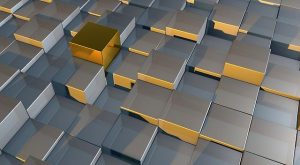What Are The Metallic Elements

In that location are currently 118 known elements on the periodic table, many of which are classified equally either a metal or nonmetal. The former are plant on the left side of the periodic table, whereas the latter are constitute on the right side of the periodic tabular array. Aside from their placement on the periodic table, though, at that place are several key differences between metallic and nonmetal elements.
What Is a Metal Chemical element?
By definition, a metallic element is an element that form positive ions and has metallic bonds. Almost elements on the periodic table are metals. Examples of metallic elements include iron, copper, silverish, mercury, pb, aluminum, gold, platinum, zinc, nickel and can.
What Is a Nonmetal Element?
A nonmetal chemical element, on the other mitt, is an chemical element that lacks the characteristics of its metal counterparts. Nonmetal elements don't grade positive ions, nor do they possess metallic bonds. Examples of nonmetal elements include hydrogen, helium, nitrogen, oxygen, fluorine, chlorine, sulfur, argon, xenon, radon and phosphorus. Nonmetal elements are rarer than metal elements, but there are all the same plenty of them bachelor on the periodic chart.
Differences Between Metal and Nonmetal Elements
At present that you know the basic definitions of metal and nonmetal elements, you might be wondering how they differ. While each element on the periodic tabular array has its own unique backdrop, all metal elements generally share some common characteristics, and all nonmetal elements also share some mutual characteristics.
For starters, metal elements take high electrical electrical conductivity properties. They are able to pass electricity with minimal restriction, making them ideal for use in wires and cables. Furthermore, metal elements accept a higher melting signal than that of nonmetal elements. In other words, it takes more heat for a metal element to cook than it does for a nonmetal element to melt. Metal elements are as well malleable and ductile, allowing them to be "worked."
Nonmetal elements accept poor electrical, also as thermal, electrical conductivity. They aren't able to pass electricity or estrus likewise every bit metal elements. Additionally, nonmetal elements have a slow appearance, which is in stark contrast to the lustrous appearance exhibited by metal elements.
What About Metalloids?
In improver to metals and nonmetals, there are too metalloids on the periodic tabular array. Metalloids are unique because their properties autumn somewhere between those of metal and nonmetal elements. They aren't particularly lustrous, nor are they are particularly dull. Rather, they fall somewhere in the centre regarding their appearance and other properties.
No tags for this postal service.
What Are The Metallic Elements,
Source: https://monroeengineering.com/blog/how-metal-elements-differ-from-nonmetal-elements/
Posted by: westbrookwhanderharty.blogspot.com


0 Response to "What Are The Metallic Elements"
Post a Comment